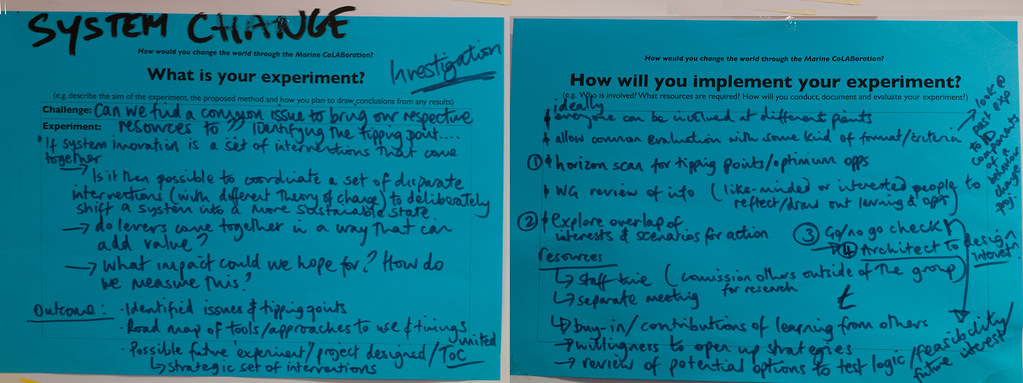Table of Contents
System Change Experiment
(an experiment from the March workshop)
Challenge/Hypothesis
What traction could we gain as a group if we focus on a single problem? Can we find a common issue to bring our respective resources to? How do we identify a tipping point?
Notes: https://www.flickr.com/photos/foam/16644580810/, larger image and another image (with post-its)
Experiment design
A pre-experiment investigation to understand what existing approaches have worked, what success factors, tools and motivations are around to create system change.
If system innovation is a set of interventions that come together:
- is it then possible to co-ordinate a set of disparate interventions (with different theories of change) to deliberately shift a system into a more sustainable state? when are these co-ordinated actions an improvement over individual uncoordinated activities?
- do levers come together in a way that can add value?
- what impact could we hope for? How do we measure this?

(Expected) Outcome:
- identified issues and tipping points
- road map of tools, effects and approaches to use and [timings?] united (reflection on what has/hasn’t worked); mapping of the existing system as it is currently understood; uncovering existing alignments and interpreting the findings
- possible future experiment for a strategic set of interventions or projects designed/TOC
- framework/survey for structured reflection
- visual theory of change
- low tech and low cost documentation
Implementation
- Ideally everyone can be included at different points
- Allow common evaluation with some kind of format/criteria (look at past experiences to identify components of a behaviour change [poj.?]
1. Horizon scan for tipping points, future opportunities,
- WG review of information (like-minded or interested people to reflect/draw out [levering?] and opps
- help uncovering emerging issues
2. Explore overlap of interests and scenarios for action (Venn diagrams of interests)
3. Go/no go check (feasibility)
4. Architect to design and [innovate?]
Resources:
- staff time (commission others outside of the group for research)
- separate meeting
- buy-in/contributions of learning from others
- willingness to open up strategies
- review of potential options to test logic, feasibility, common tipping points and future interest
Needs
- Contributions of knowledge and learning to identify components of behaviour change; case studies, reflection, stories, suggestions, interpretation/analysis
- Come to group discussion
- Buy-in to horizon scanning and where [xxx] to intervene
- Suggestion of others outside of the group
- Testing the logic
Offers
- MVL: Time, examples, analysis, [Lessons learned?], horizon scanning
- Nic: My time, reflection on past experiences, horizon scanning, interpretation, experimental project design
- Andrew Farmer: Horizon scanning, meetings
- Amy: Time, ideas, experiences, horizon scanning, meeting venue, cake
- Sue: review of success and what has worked
- NEF: share our experience, lessons in campaigning, training and movement building
- SL: Review of lessons learned, horizon scanning [+planning?]
- Louisa [intelligence?] from outside [around context?]
- Giles: System [xxx] architecture, [getting up?] hypothesis of what needs to happen when; [Horizon Scanning xxxxxxx → can’t read that whole post-it]; Look at [xxx] [“xxx”] elements from each [initiative?]
